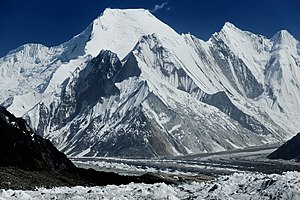Chogolisa
| Chogolisa | ||
|---|---|---|
|
Chogolisa from the shoulder of K2 seen from |
||
| height | 7668 m | |
| location | Gilgit-Baltistan ( Pakistan ) | |
| Mountains | Masherbrum Mountains ( Karakoram ) | |
| Dominance | 16.51 km → Gasherbrum I ( Hidden Peak ) | |
| Notch height | 1624 m ↓ Conway saddle ( 6044 m ) | |
| Coordinates | 35 ° 36 '44 " N , 76 ° 34' 15" E | |
|
|
||
| First ascent | August 2nd, 1975 by Fred Pressl and Gustav Ammerer | |
|
seen from the Godwin Austen Glacier |
||
The Chogolisa is a 7668 m high trapezoidal mountain in the Karakoram in the autonomous region of Gilgit-Baltistan in Pakistan . An almost horizontal, 900 m long summit ridge connects the 7668 m high south-west summit with the 7654 m high north-east summit . The latter is also known as Chogolisa II or, after William Martin Conway , because of its fluted ice walls, which resemble a bridal veil, as Bride Peak . Günter O. Dyhrenfurth described the Chogolisa as "the ideal of an iceberg".
Position and shape
The Chogolisa is one of the Masherbrum Mountains , a mountain range of the "Little Karakoram" south of the Baltoro Glacier . Your reference mountain with regard to the Schartenhöhe is not the Masherbrum as the highest mountain in the chain, but the Hidden Peak in neighboring Baltoro Muztagh . The shape of the hipped roof of the Chogolisa is remarkably symmetrical on all sides and, despite its great height, makes it a distinctive mountain figure of the Baltoro.
Surname
The name Chogolisa is in the native language of the Balti Chhogolingsa and means "large hunting area" (composed of chhogo "large", ling "hunt" and sa "area, area").
Ascent history
As early as 1909, an expedition led by Luigi Amadeo of Savoy , the Duke of Abruzzo, reached an altitude of almost 7500 m on the southeast ridge . A bad weather forced the team to turn back. The base camp for this first attempt at ascent was set up on the north side of the mountain, and a high camp was located on the Chogolisasattel at an altitude of 6335 m . The turning point at 7,500 m remained the greatest height reached by humans until the British Everest expedition of 1922.
Hermann Buhl and Kurt Diemberger attempted an ascent in 1957 after having successfully climbed Broad Peak with Marcus Schmuck and Fritz Wintersteller a few days earlier . On June 25th, they left their first camp and bivouacked on a saddle 6706 m above sea level on the east ridge. On June 27, they had to turn back just 300 m below the summit of Chogolisa II because of a sudden snow storm. During the descent, Buhl lost his orientation and fell over the north face at an altitude of about 7300 m through Wechtenbruch . His body was missing.
In 1958, M. Fujihira and K. Hirai, members of a Japanese expedition from the University of Kyoto , led by T. Kawabara, reached the summit of Chogolisa II.
The main summit of the Chogolisa was first reached on August 2, 1975 by Fred Pressl and Gustav Ammerer, both members of an Austrian expedition led by Eduard Koblmüller . Two days later, on August 4, 1975, Hilmar Sturm and Alois Furtner also climbed the summit, after having secured the key point a week earlier - a 1000 m high, 55 ° steep ice wall to the 6700 m high Kaberi saddle . Expedition leader Koblmüller suffered almost the same fate as Buhl - a cornice broke beneath him, also on the descent . However, he was roped and his comrades could hold the fall.
Web links
- Chogolisa on Peakbagger.com (English)
- Chogolisa at Peakware (English)
- Chogolisa / Bride Peak Everest News (English)
Individual evidence
- ^ Günter Oskar Dyhrenfurth: Demon Himalaya - Report of the International Karakoram Expedition 1934. In: Google Books. Retrieved on May 13, 2018 (German).
- ^ H. Adams Carter: Balti Place Names in the Karakoram , in: American Alpine Journal, 1975, p. 52 ff. ( Text online )
- ↑ Günter Seyfferth: Height records in the Himalayas. In: Himalaya.org. Retrieved May 13, 2018 .
- ↑ Hermann Buhl broadpeak.org
- ↑ See also the section "Chogolisa - Hermann Buhl's grave" in Broad Peak: Expedition 1957 broadpeak.org
- ^ Takeo Kuwabara: Japanese Alpinists in the Himalaya . American Alpine Journal, 1959, Vol. 11.
- ^ Eduard Koblmüller: Asia, Pakistan, Chogolisa . American Alpine Journal, 1976, vol. 20.


